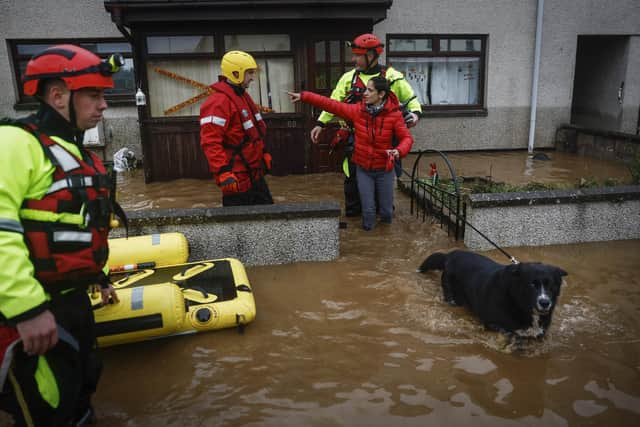Climate change: Increased flood risk means we need to free rivers from artificial channels created centuries ago – Hamish Moir
Flooding as a likely consequence of climate change shows no sign of abating in Scotland and elsewhere. People whose homes are near rivers live perpetually on the edge, with Scottish Fire and Rescue Service figures showing 3,139 reported flooding incidents in 2022-23, up from 1,617 the previous year.
Take the example of Brechin, which was heavily flooded last October during Storm Babet. The river burst its banks, overwhelming flood defences and leaving residents facing evacuation to hotels for Christmas. In Brechin, the flood defences were designed to deal with water level rises of up to 3.8 metres. However, that was not enough, and now flood-related repairs are set to cost almost £4 million. Many will be asking themselves why flood defences fail year after year, and why more is not being done to stop this happening again.
Advertisement
Hide AdAdvertisement
Hide AdOne of the big problems is that much of our flood defences were designed based on past environmental conditions. However, the effects of accelerating climate change mean that our heavily managed rivers are not equipped for current and future patterns of flood size and frequency.


Best architect of its own form
From the late-18th century onwards, many Scottish rivers were straightened to make them more drainage efficient and to define ‘neat’ boundaries between properties and fields. River banks were often engineered – typically using concrete and rock – to keep channels straight.
The problem is that forcing a river into a fixed, straightened course makes it less resilient to the effects of climate change. Channels engineered in this way can’t naturally adjust in response to changing flood patterns that also control the movement of sediments. As a result, artificial channels are often compromised by floods.
A river is the best architect of its own form. Rivers innately and continuously strive to maintain or return to their natural character, often a meandering pattern. If artificial constraints to natural processes (like rock-protected banks) are removed and the river is given more space, it will naturally develop a more sustainable condition that better manages the changing flow of water under climate change.
In addition to considerable biodiversity benefits, allowing the river to adjust to this new equilibrium will permit a more natural connection with its floodplain, providing increased storage of floodwater and reducing the risk to built-up areas further downstream. The process of rivers expanding into their floodplains and then gradually retreating also helps to naturally treat water quality.
Farmers should be compensated
We need to set aside land along rivers to function as floodplains, a cheaper and more sustainable approach to dealing with flood risks in the long term than investing huge amounts of money in ‘traditional’, engineered flood defences.
Can we do this? We will need farmers onside. Often it is more cost effective to use land for functional floodplain purposes than it is for farming, particularly in locations where agricultural is marginal economically. However, this will understandably be of concern to some farmers, who fear bearing the cost of such adaptation themselves.
One solution is subsidised incentives paid to farmers who are prepared to give some of their land over to make space for natural river processes – subsidies similar to those which are currently available for rewilding farm land. If this is possible, we will be able to develop a more resilient and sustainable environment to permit adaptation in relation to climate and land-use change.
Advertisement
Hide AdAdvertisement
Hide AdHamish Moir is the founder of Scottish river restoration and management consultancy cbec eco-engineering, an RSK Group company, which is working on a project in Scotland to allow a river not far from Brechin to naturally function within its floodplain
Comments
Want to join the conversation? Please or to comment on this article.